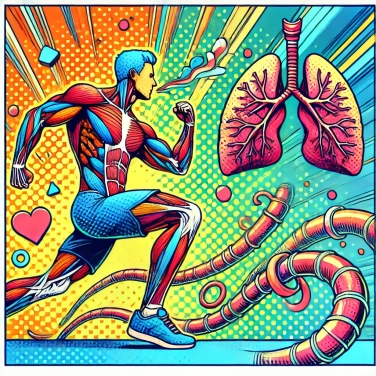The bronchi dilate during exercise to increase the flow of air to the lungs, allowing for an increased supply of oxygen to meet the body's needs during physical exertion.

When exercising, the bronchi naturally widen to allow more air to pass through. This dilation, also known as bronchodilation, occurs thanks to small muscles surrounding the bronchi, called bronchial smooth muscles. During exertion, the body detects an increased need for oxygen and releases certain substances, notably adrenaline. This hormone acts directly on these bronchial muscles by causing them to relax quickly to open the airways further. As a result, air flows more easily, allowing the lungs to absorb more oxygen and efficiently expel carbon dioxide. This phenomenon enables the body to perform better for longer during physical activity.
When you engage in physical effort, your body needs more air to fuel the extra energy required by your muscles. You breathe faster and deeper, and your bronchi understand this well. They dilate widely (bronchodilation) to allow air to pass more easily into your lungs. As a result, your breathing becomes more efficient, easy, and fluid. This opening of the bronchi is mainly managed by your body, which releases certain substances, particularly adrenaline. This helps your lungs to take in more oxygen when you move and your energy expenditure increases. Essentially, it's a kind of clever natural reflex to support effort without making you feel suffocated.
During exertion, it is mainly the sympathetic autonomic nervous system that comes into action and stimulates our bronchi to dilate. Basically, this automatic nervous system takes over without you realizing it, to help the body cope with physical effort. It then sends signals that relax the muscles surrounding the bronchi, promoting their widening. As a result, you breathe much better and deeper, your gas exchanges are optimized, and you can exert more intense effort. Conversely, the parasympathetic autonomic nervous system would have the opposite effect (narrowing the bronchi), but it is somewhat on standby during sports activity.
When you exert intense effort, your body quickly reacts by releasing a key hormone: adrenaline. This molecule, often referred to as the stress hormone or the action hormone, acts directly on the bronchi. How? It binds to specific receptors located on the walls of the bronchi, causing them to relax and thus dilate. The result? An immediate increase in the diameter of the airways, allowing air to flow more easily and in greater quantities to the lungs. In short, adrenaline enables your body to optimize your oxygen intake just when it needs it most, especially during exercise.
Regular bronchodilation through exercise offers a host of long-term benefits. Firstly, it significantly improves your respiratory capacity, allowing you to better oxygenate your muscles and generally feel less out of breath in your daily life. It also makes your lungs more efficient: you breathe more deeply and with less effort over time. Moreover, in terms of health, maintaining regular physical activity strengthens your resistance to asthma attacks and reduces the risk of developing chronic respiratory problems. Finally, this sporting habit limits respiratory fatigue and gradually enhances endurance, making you increasingly comfortable when you move.
Some studies show that deep and controlled breathing during physical activity helps maintain bronchial dilation for a longer period, thereby maximizing the benefits of sport on the respiratory system.
During exercise, the body naturally releases adrenaline, a hormone that encourages the dilation of the bronchi to optimize gas exchange and improve oxygen supply to the active muscles.
Regular training improves lung capacity, but it doesn't actually change the physical size of the lungs. In reality, what improves is ventilatory efficiency and the ability of the respiratory muscles to strengthen and function better.
In people with asthma, moderate physical exercise can contribute in the long term to reducing bronchial sensitivity, thus decreasing the frequency and intensity of asthma attacks.
Yes, stress can influence bronchial dilation through the sympathetic autonomic nervous system. When you are stressed, your body releases more adrenaline, which generally contributes to bronchodilation. However, in cases of chronic or excessive stress, this can also lead to episodes of hyperventilation or paradoxical bronchoconstriction.
These sensations may indicate irritation of the airways or exercise-induced asthma. During intense exercise, hyperventilation can cool and dry out the airways, leading to slight inflammation and thus bronchoconstriction. If symptoms persist or occur frequently, consult a doctor.
You can improve your respiratory capacity by regularly engaging in moderate cardiovascular exercises, performing specific breathing exercises (such as diaphragmatic technique), and adopting a suitable posture that allows for better expansion of the lungs and bronchi.
Yes, in general, exercise-induced bronchial dilation can be beneficial for people with asthma. However, in some individuals, intense exertion can instead trigger an asthma attack (exercise-induced asthma). Therefore, it is advisable to consult a healthcare professional to properly tailor physical activity.
Endurance exercises such as running, cycling, or swimming particularly stimulate bronchodilation by increasing the demand for oxygen and activating the response of the autonomic nervous system and adrenaline, thereby promoting bronchodilation.

0% of respondents passed this quiz completely!
Question 1/5